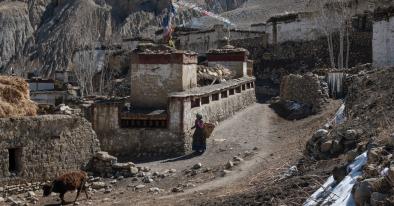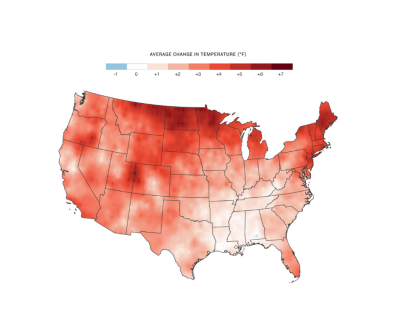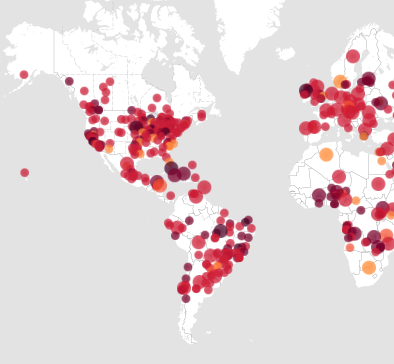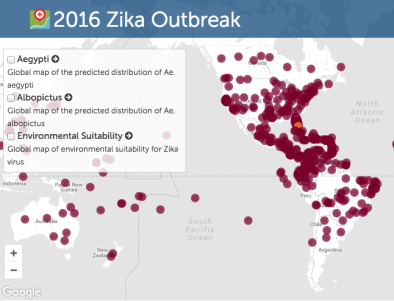

Vector-Borne Disease Risk Increase
Vector-borne diseases are those carried by organisms, usually biting insects or ticks, that transmit them to humans or other organisms.[1] Climate factors, especially high and low temperature extremes and precipitation patterns, have a significant impact on the seasonality, geographic range and pervasiveness of vector-borne diseases.[1]
Global warming is pushing average temperatures up; making heat waves more intense, frequent and long-lasting; and driving increased extreme precipitation. These and other climate changes influence the reproduction, development, behavior, and population dynamics of insects, pathogens, and people. As all these factors interact in new ways, it becomes more difficult to predict how vector-borne diseases will behave. Thus, risk increases.
Read More





Climate science at a glance
- By completely rewiring the network of animal viruses, climate change is creating a new age of infectious dangers.
- Insect vectors also have several physical traits that help them take advantage of climate change impacts like flooding, increased precipitation, and warmer weather.
- The effect of climate change on infectious disease is complex because many factors interact to influence transmission dynamics.
- The dominant drivers of widespread pathogens, like West Nile virus, can be challenging to identify due to regional variability in vector and host ecology, with past studies producing disparate findings.
US vector-borne disease trends and climate change
- (Paull et al. 2017): A February 2017 study examining 15 years of data on West Nile virus infections in people across the United States found that epidemics were larger during years of drought.[1] There were also bigger outbreaks in areas that had not experienced large epidemics of the mosquito-borne virus in the past.[1]
- (CDC 2018): During 2008–2015, Lyme disease case counts have increased in states that neighbor those with high incidence.[2]
- (Kenward and Brady 2017): 76 percent of major cities in the US have seen an overall increase in days conducive for mosquitoes from 1980 to 2016, and many regions have seen the mosquito season increase by half a month or more.[3]
- (Eisen et al. 2016): When combined, I. scapularis and I. pacificus—the primary Lyme disease vectors in the east and western US respectively—were identified in 44.7% more counties than in 1998.[4]
- (Kolivras 2010): In Hawaii, dengue risk areas generally contract during El Niño-induced droughts and expand as a result of increased precipitation received during La Niña events.[5]
Global vector-borne disease trends and climate change
- (Mutheneni et al. 2017): There is a significant association between dengue cases — the number of which has gradually increased in India over the last decade — and precipitation in the Indian states of the states of Punjab, Haryana, Gujarat, Rajasthan and Kerala.[6]
- (Kraemer et al. 2015): The distributions of Aedes aegypti and Aedes albopictus mosquitoes, both vectors of dengue and chikungunya, are the widest ever recorded; now extensive in all continents except Antarctica.[7]
- (Schuler-Faccini 2016): Among a cohort of 35 infants with microcephaly born during August–October 2015 in eight of Brazil’s 26 states and reported to the registry, the mothers of all 35 had lived in or visited Zika virus-affected areas during pregnancy.[8]
- (Paull et al. 2017): Drought was the primary climatic driver of increased West Nile virus epidemics, and that local-scale data from one region suggested drought increased epidemics via changes in mosquito infection prevalence rather than mosquito abundance.[1]
- (Ding et al. 2014): In Mengcheng County, China, an increased risk of malaria was significantly associated with flooding, waterlogging, or the two together.[9]
Global studies attribute increased vector-borne disease risk to climate change
- (Carlson et al. 2022): Climate change is becoming the biggest upstream risk factor for disease emergence—exceeding higher-profile issues like deforestation, wildlife trade, and industrial agriculture. Even under the most optimistic climate scenarios, the coming decades will see roughly 300,000 first encounters between species that normally don’t interact, leading to about 15,000 spillovers wherein viruses enter naive hosts.
- (Caminade et al. 2016): The temperature conditions that were exceptionally conducive for mosquito-borne transmission of Zika virus in 2015 over South America can be related to the superposition of climate change and decadal and year to year variability.[10]








